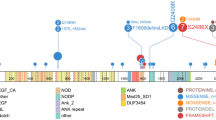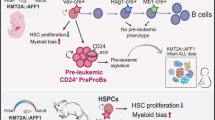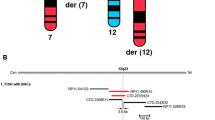Abstract
Familial pseudohyperkalaemia (FP) is a symptomless, dominantly inherited red cell trait, which shows a ‘passive leak’ of K+ cations into the plasma upon storage of blood at room temperature (or below). There are no haematological abnormalities. The loss of K+ is due to a change in the temperature dependence of the leak. The Scottish case initially described, FP Edinburgh, maps to 16q23-qter. Here we studied a large kindred of Flemish descent with FP, termed FP Lille, which was phenotypically identical to the Edinburgh FP. In FP Lille, however, the responsible locus mapped to 2q35–36, with a Lod score of 8.46 for marker D2S1338. We infer that FP Edinburgh and FP Lille, although they are phenocopies of one another, stem from two distinct loci, FP1 (16q23-qter) and FP2 (2q35–36), respectively. This duality hints at the possibility that the protein mediating the leak might be a heterodimer. No mutation was found in three plausibly candidate genes: the KCNE4 gene, the TUBA1 gene and a predicted gene located in genomic contig NT_005403.
Similar content being viewed by others
Log in or create a free account to read this content
Gain free access to this article, as well as selected content from this journal and more on nature.com
or
References
Stewart GW, Corrall RJM, Fyffe JA, Stockdill GM, Strong JA : Familial pseudohyperkalemia. A new syndrome. Lancet 1979; ii: 175–177.
Iolascon A, Stewart GW, Ajetunmobi JF et al: Familial pseudohyperkalemia maps to the same locus as dehydrated hereditary stomatocytosis (hereditary xerocytosis). Blood 1999; 93: 3120–3123.
Coles SE, Ho MM, Chetty MC, Nicolaou A, Stewart GW : A variant of hereditary stomatocytosis with marked pseudohyperkalemia. Br J Haematol 1999; 104: 275–283.
Vantyghem MC, Dagher G, Doise B et al: Pseudo-hyperkaliemie. A propos d'une observation familiale. Ann Endocrinol 1991; 52: 104–108.
Grootenboer S, Schischmanoff PO, Laurendeau I et al: Pleiotropic syndrome of dehydrated hereditary stomatocytosis, pseudohyperkalemia, and perinatal edema maps to 16q23–q24. Blood 2000; 96: 2599–2605.
Ott J : Analysis of Human Genetic Linkage. Baltimore: Johns Hopkins University Press, 1991.
Mukhopadhyay N, Almsay L, Schroeder M, Mulvihill WP, Weeks DE : Mega2, a data-handling program for facilitating genetic linkage and association analyses. Am J Hum Genet 1999; 65: abs 2474, pp a436.
Stewart GW, Ellory JC : A family with mild xerocytosis showing increased cation permeability at low temperatures. Clin Sci 1985; 69: 309–319.
Haines P, Crawley C, Chetty M et al: Familial pseudohyperkalaemia Chiswick: a novel congenital thermotropic variant of K and Na transport across the human red cell membrane. Br J Haematol 2001; 112: 469–474.
Gore DM, Chetty MC, Fisher J, Nicolaou A, Stewart GW : Familial pseudohyperkalaemia Cardiff: a mild version of cryohydrocytosis. Br J Haematol 2002; 117: 212–214.
Carella M, Stewart GW, Ajetunmobi JF et al: Genomewide search for dehydrated hereditary stomatocytosis (hereditary xerocytosis): mapping of locus to chromosome 16 (q23-qter). Am J Hum Genet 1998; 63: 810–816.
Acknowledgements
We thank the family for their enthusiastic cooperation and hospitality, Mrs Ingrid Laurendeau, Drs Guy Lalau and Pierre-Oliver Schischmanoff for performing some of the preliminary parts of the investigation, and Pr Gil Tchernia for stimulating discussions. We thank Margaret Chetty for excellent technical assistance. This work was supported by Telethon (prog. E0783, prog. GP0202Y02), by AIRC, Associazione per la Lotta al Neuroblastoma, Progetto ACRO-CNR and MURST progetti PRIN (Italy) and by MIUR FIRB project (AI), the INSERM (U 473) and the INSERM/AFM (Project no 4MR09F) (JD), and the Sir Jules Thorn Trust for funding (GWS).
Author information
Authors and Affiliations
Corresponding author
Rights and permissions
About this article
Cite this article
Carella, M., d'Adamo, A., Grootenboer-Mignot, S. et al. A second locus mapping to 2q35–36 for familial pseudohyperkalaemia. Eur J Hum Genet 12, 1073–1076 (2004). https://doi.org/10.1038/sj.ejhg.5201280
Received:
Revised:
Accepted:
Published:
Issue date:
DOI: https://doi.org/10.1038/sj.ejhg.5201280



